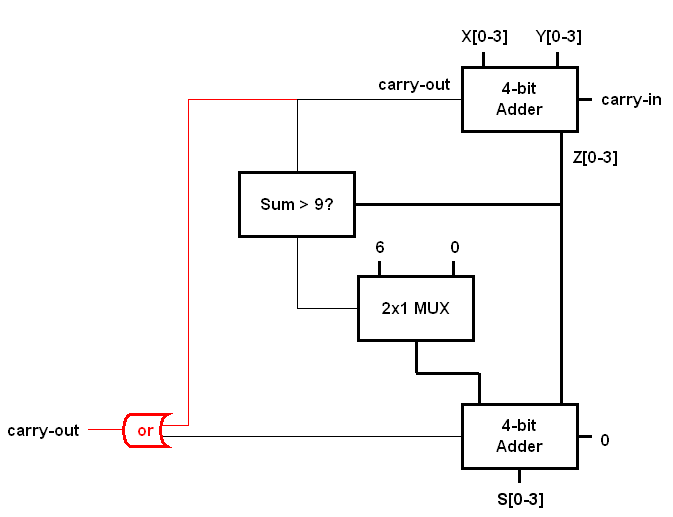|
Experiments |
|
|
|
||
|
Experiment No. 4: BCD Adders Objectives |
||||||||||||||||||||||||||||||||||||||||||||||||||||||||||||||||||||||||||||||||||||||||||||||||||||||||||||||||||||||||||||||||||||||||||||||||||||||||||
|
||||||||||||||||||||||||||||||||||||||||||||||||||||||||||||||||||||||||||||||||||||||||||||||||||||||||||||||||||||||||||||||||||||||||||||||||||||||||||
|
Discussion |
||||||||||||||||||||||||||||||||||||||||||||||||||||||||||||||||||||||||||||||||||||||||||||||||||||||||||||||||||||||||||||||||||||||||||||||||||||||||||
|
In the BCD representation system each digit is encoded
into its binary equivalent with four (4) bits. (Why are no more or no less number of bits used?).
Observe that only 10 of the 16 possible bit-patterns are used in BCD. That means the remaining 6 patterns could be treated as don't-care cases. For the arithmetic addition of two decimal digits in BCD, the maximum value that may be produced as the result is 9 + 9 + 1 = 19 (two largest operands plus the carry). If we try to add two decimal digits in BCD with a 4-bit ripple-carry adder we will get a binary sum ranging from 0 to 19. When the binary sum is less than or equal to 9, it also correctly represents the sum in BCD. When the binary sum is greater than 9, however, it does not represent the correct BCD sum. The sum in BCD is to be obtained by adding 6 to it. Perform the following addition in BCD as explained above: 1) 7 + 4 The above examples should help you realize when the conversion is necessary and what should be done to perform the conversion correctly. Here is a block diagram of a 1-digit BCD adder
Complete the truth table below.
|
||||||||||||||||||||||||||||||||||||||||||||||||||||||||||||||||||||||||||||||||||||||||||||||||||||||||||||||||||||||||||||||||||||||||||||||||||||||||||
|
Prelab |
||||||||||||||||||||||||||||||||||||||||||||||||||||||||||||||||||||||||||||||||||||||||||||||||||||||||||||||||||||||||||||||||||||||||||||||||||||||||||
|
||||||||||||||||||||||||||||||||||||||||||||||||||||||||||||||||||||||||||||||||||||||||||||||||||||||||||||||||||||||||||||||||||||||||||||||||||||||||||
|
Procedure |
||||||||||||||||||||||||||||||||||||||||||||||||||||||||||||||||||||||||||||||||||||||||||||||||||||||||||||||||||||||||||||||||||||||||||||||||||||||||||
Note: You can use the gnd symbol to simulate
a zero, and the vcc symbol to simulate a one, if necessary.
o 0 + 0 o 9 + 10 o 99 + 99 o 16 + 64 Save this project as 2digitBCD in the folder Lab4. |
||||||||||||||||||||||||||||||||||||||||||||||||||||||||||||||||||||||||||||||||||||||||||||||||||||||||||||||||||||||||||||||||||||||||||||||||||||||||||
|
What to turn in |
||||||||||||||||||||||||||||||||||||||||||||||||||||||||||||||||||||||||||||||||||||||||||||||||||||||||||||||||||||||||||||||||||||||||||||||||||||||||||
|
||||||||||||||||||||||||||||||||||||||||||||||||||||||||||||||||||||||||||||||||||||||||||||||||||||||||||||||||||||||||||||||||||||||||||||||||||||||||||
